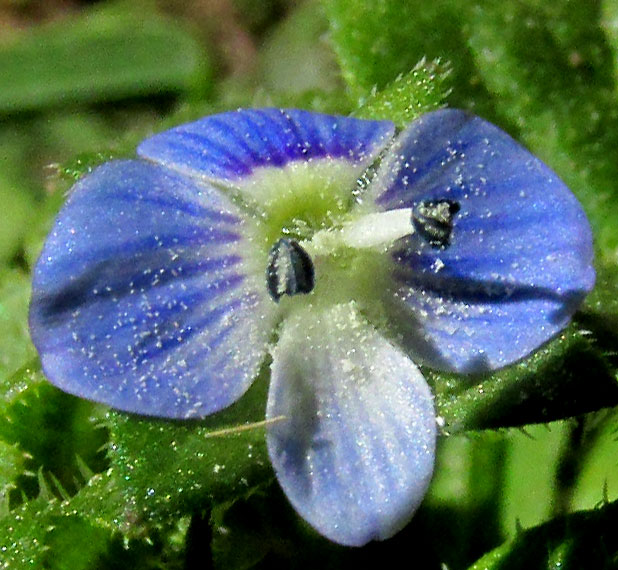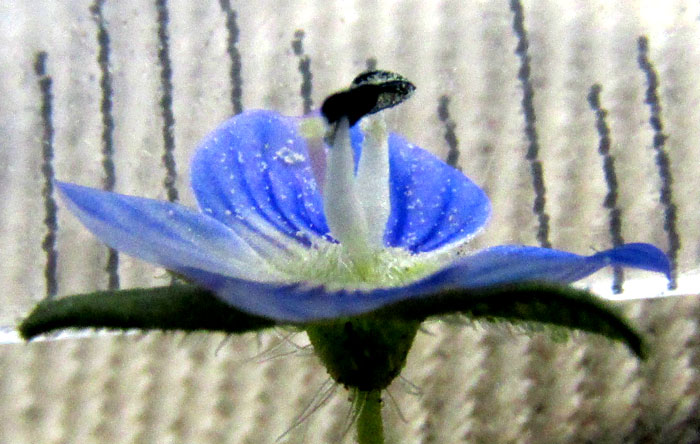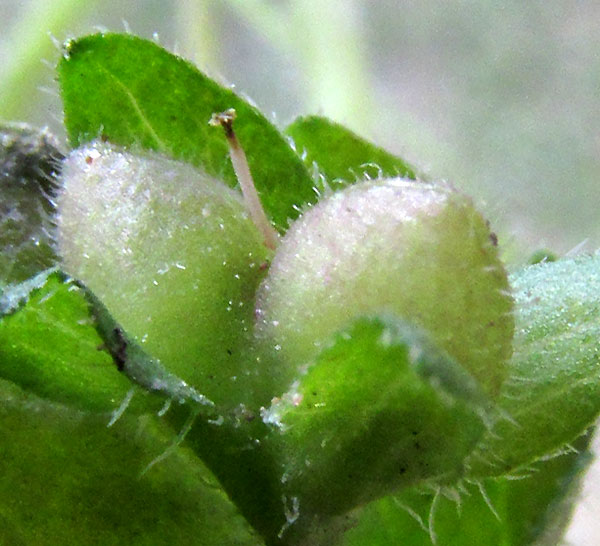Excerpts from Jim Conrad's
Naturalist Newsletter
entry dated January 2, 2023, issued from near Tequisquiapan, elevation about 1,900m (6200 ft), ~N20.57°, ~ W99.89°, Querétaro state, MÉXICO
Gray Speedwell

In the dry-season, crispy-brown backyard lawn of a home in a small village, at the grassy edge of an ornamental, sporadically watered rose bush, the above little wildflower was flowering as if it were up north during the very early spring. In fact, at first I thought it was the Ivy-leaved Speedwell which in many lawns in the US appears as early as February in the special microclimate created by reflected sunlight at the bases of southern-facing house walls. But something seemed a little different about this plant.

With its two stamens and four blue petals forming a tiny flower with a white throat, we definitely had a speedwell, genus Veronica in the Plantain Family, and the blossom was fairly similar to the Ivy-leaved species. However, on the vegetative parts surrounding the flower the broad-based hairs weren't as long as on the Ivy-leaved Speedwell. Well, such variations might be just regional ones. Measuring the flower provided more insight:

The above image shows that our blossom is about 9mm wide. The Flora of North America gives the diameter of the Ivy-leaved Speedwell, Veronica hederifolia, as 5-7(-9)mm, so if this is that species, our individual produces exceptionally large flowers. Fortunately, on our plant the season's first capsular-type fruit was just beginning to mature:

Above, the fading remnants of the flower's slender style protrudes from the notch between the fruit's two lobes. The Flora of North America gives the Ivy-leaved Speedwell's style length as (0.6-)07-0.9(-1.1)mm. Our style is longer than the Ivy-leaved's longest of 1.1mm. Also, on the Internet, when comparing the leaf shape of the two species, it's apparent that the Ivy-leaved's leaves seldom develop more than two shallow indentations along their margins, while on ours, as shown in our top picture, the leaves habitually display four or five indentations.
However, the world of speedwells is much larger than just the commonly occurring Ivy-leaved, and whatever our little weed/wildflower in a Mexican backyard happens to be. About 450 species of the genus Veronica are recognized worldwide, with 34 species found in North America, and just in the Central Mexican Valley around Mexico City at least nine species have been documented.

In our area, if you have a Veronica whose flowers arise from the tip of the stem and not from leaf axils, it's an annual and not a perennial, the flowers' pedicels are abour 20mm long (as seen at the right), the leaves are not lobed but bear four or five broad, shallow teeth, the flowers are blue with a white throat, the plant sprawls instead of standing erect, and the calyx lobes are broadly oval as seen best in the above fruit picture, not much narrower, you have VERONICA POLITA, often known as the Gray Speedwell, Gray Field Speedwell or Wayside Speedwell, though I don't see anything gray about it. The polita in the binomial means "polished" or "smoothed," and I can't see much polished or smoothed about it, either, but that's the way names go.
The Gray Speedwell is native to southeastern Europe, but is invasive nearly worldwide, where it occupies cultivated land and horticultural and domestic habitats, like our Mexican backyard.
With a name like speedwell it's not surprising that traditionally our plant has been used to heal wounds and treat rheumatism and various other human infirmities. In a 2019 publication by Bahare Salehi and many others, entitled "Veronica Plants -- drifting from Farm to Traditional Healing, Food Application, and Phytopharmacology," extracts of the Gray Speedwell are said to show "dose-dependent cytotoxicity against KB (human epidermoid carcinoma) and B16 (mouse melanoma) cells." This indicates potential use to control certain cancerous cells. Gray Speedwell has a "high content of total phenols and flavonoids," explaining its efficacy with both cancer treatment and intestinal inflammation.
The Flora of China claims that the stems and leaves are "sweet and edible." I ate the sprigs photographed above and found them not at all sweet, though if cooked they might be. However, they were crunchy and not at all bitter like most wild herbs eaten raw. A few raw sprigs in a tossed salad would be OK, and certainly they could be cooked with other wild greens.